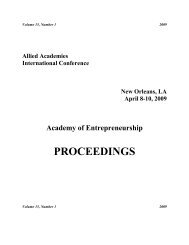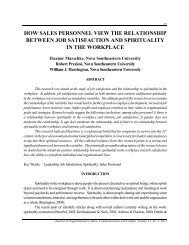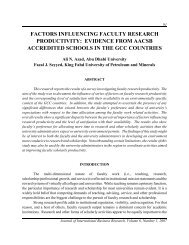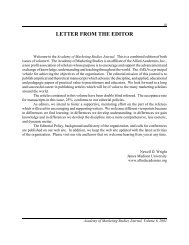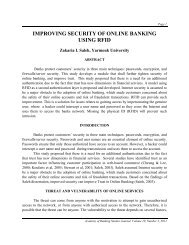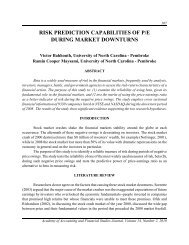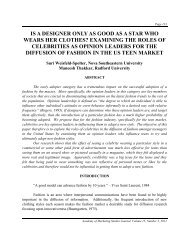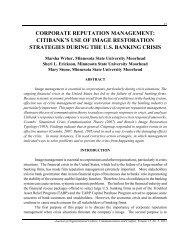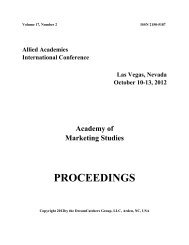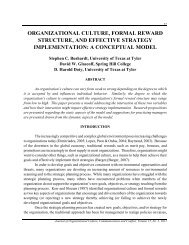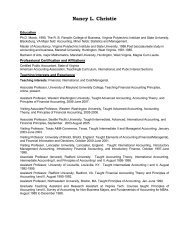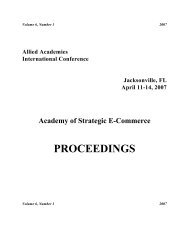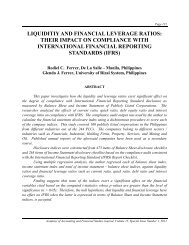satisfaction and repurchase intention - Allied Academies
satisfaction and repurchase intention - Allied Academies
satisfaction and repurchase intention - Allied Academies
You also want an ePaper? Increase the reach of your titles
YUMPU automatically turns print PDFs into web optimized ePapers that Google loves.
Page 11<br />
SATISFACTION AND REPURCHASE INTENTION: B2B<br />
BUYER-SELLER RELATIONSHIPS IN MEDIUM-<br />
TECHNOLOGY INDUSTRIES<br />
Gregory M. Kellar, Wright State University<br />
Michael W. Preis, University of Illinois at Urbana-Champaign<br />
ABSTRACT<br />
Customer <strong>satisfaction</strong> <strong>and</strong> <strong>repurchase</strong> <strong>intention</strong>s are examined in B2B markets for<br />
medium-technology offerings; overall customer <strong>satisfaction</strong> <strong>and</strong> <strong>repurchase</strong> <strong>intention</strong> are<br />
modeled as functions of three components of overall <strong>satisfaction</strong>: <strong>satisfaction</strong> with the<br />
interpersonal relationship with the salesperson, <strong>satisfaction</strong> with vendor performance, <strong>and</strong><br />
product <strong>satisfaction</strong>. The Chow test confirms that overall customer <strong>satisfaction</strong> is different than<br />
<strong>repurchase</strong> <strong>intention</strong> in medium technology industries. Information theoretic techniques are then<br />
applied to variable subset selection to derive optimal linear regression models for overall<br />
customer <strong>satisfaction</strong> <strong>and</strong> <strong>repurchase</strong> <strong>intention</strong> in medium-tech industries. Results explain<br />
approximately 64% of the variance of overall <strong>satisfaction</strong> <strong>and</strong> 37% of the variance of <strong>repurchase</strong><br />
<strong>intention</strong>. The optimal model for overall <strong>satisfaction</strong> includes terms for all three components of<br />
<strong>satisfaction</strong> while the optimal model for <strong>repurchase</strong> <strong>intention</strong> includes terms for only product<br />
<strong>satisfaction</strong> <strong>and</strong> interpersonal <strong>satisfaction</strong>.<br />
INTRODUCTION<br />
It is important for supply chain practitioners to underst<strong>and</strong> customers’ <strong>repurchase</strong><br />
<strong>intention</strong>s <strong>and</strong> the factors that influence <strong>repurchase</strong> <strong>intention</strong>s (Patterson, Johnson & Spreng,<br />
1997) because increased <strong>repurchase</strong>s (customer loyalty) are important to profitability (Fornell,<br />
1992). Patterson, Johnson, <strong>and</strong> Spreng (1997), Shapiro, Slywotzky <strong>and</strong> Doyle (1997), <strong>and</strong> Preis<br />
(2003) find increased customer <strong>satisfaction</strong> is one factor leading to such increased <strong>repurchase</strong><br />
<strong>intention</strong>s. Thus, it is important to obtain a good underst<strong>and</strong>ing of the factors that affect<br />
<strong>satisfaction</strong> <strong>and</strong> hence influence <strong>repurchase</strong> <strong>intention</strong>s.<br />
While a great deal of research on customer <strong>satisfaction</strong> has been performed in consumer<br />
markets, the influence of customer <strong>satisfaction</strong> on supply chains has been largely ignored<br />
(Patterson, Johnson & Spreng, 1997; Szymanski & Henard, 2001; Homburg & Rudolph, 2000).<br />
Kellar <strong>and</strong> Preis (2003) show that the components of <strong>satisfaction</strong> that influence <strong>repurchase</strong><br />
<strong>intention</strong> are different for high-tech <strong>and</strong> low-tech industries. This finding naturally leads to the<br />
question of whether components of <strong>satisfaction</strong> for offerings from industries that are neither<br />
high-tech nor low-tech, i.e., medium-tech, differ substantially from those from high-tech <strong>and</strong><br />
Academy of Information <strong>and</strong> Management Sciences Journal, Volume 14, Number 2, 2011
The body of this manuscript is not reproduced in this posting. The full text of the manuscript is<br />
available through most university libraries. Should you have difficulty in finding the full text,<br />
you may acquire it from the original journal. Visit http://www.alliedacademies.org to find a link<br />
to the original journal source.
Page 24<br />
Keiningham, Perkins-Munn <strong>and</strong> Evans (2003) find a positive relationship between<br />
customer <strong>satisfaction</strong> <strong>and</strong> share-of-wallet for services in the B2B sector. Similar research on the<br />
relationship between components of <strong>satisfaction</strong> <strong>and</strong> share-of-wallet, <strong>repurchase</strong> <strong>intention</strong> <strong>and</strong><br />
share-of-wallet (i.e., between <strong>repurchase</strong> <strong>intention</strong> <strong>and</strong> actual <strong>repurchase</strong>), <strong>and</strong> <strong>satisfaction</strong> <strong>and</strong><br />
share-of wallet for goods, would all be interesting <strong>and</strong> useful topics to explore.<br />
CONCLUSION<br />
Models have been developed for the effects of three components of <strong>satisfaction</strong> on both<br />
overall <strong>satisfaction</strong> <strong>and</strong> <strong>repurchase</strong> <strong>intention</strong>; the three components examined are <strong>satisfaction</strong><br />
with the product, <strong>satisfaction</strong> with vendor performance, <strong>and</strong> interpersonal <strong>satisfaction</strong>. Results<br />
demonstrate that significant differences exist between the components of <strong>satisfaction</strong> that<br />
influence industrial buyers’ evaluations of overall <strong>satisfaction</strong> <strong>and</strong> the components of <strong>satisfaction</strong><br />
affecting <strong>repurchase</strong> <strong>intention</strong> for offerings from medium-tech industries. More of the variance in<br />
overall <strong>satisfaction</strong> is explained by the components of <strong>satisfaction</strong> than is explained in <strong>repurchase</strong><br />
<strong>intention</strong>.<br />
REFERENCES<br />
Anderson, Eugene W. & Mary W. Sullivan (1993). The antecedents <strong>and</strong> consequences of customer <strong>satisfaction</strong> for<br />
firms. Marketing Science, Spring, 12(2), 125 – 143.<br />
Bachmann, Duane P., John Elfrink, & Gary Vazzana (2000). E-mail <strong>and</strong> snail mail face off in rematch. Marketing<br />
Research, Winter/Spring, 11(4), 10 – 15.<br />
Bloemer, J. M. M. & T. B. C. Poiesz (1989). The illusion of customer <strong>satisfaction</strong>. Journal of Customer<br />
Satisfaction, Dis<strong>satisfaction</strong> <strong>and</strong> Complaining Behavior, 2, 43 – 48.<br />
Bradley, Nigel (1999). Sampling for Internet surveys. An examination of respondent selection for Internet research.<br />
Journal of the Market Research Society, October, 41(4), 387 – 395.<br />
Burnham, Kenneth P. & David R. Anderson (2002). Model selection <strong>and</strong> multimodel inference, New York, NY:<br />
Springer.<br />
Capraro, Anthony J.; Susan Broniarczyk & Rajendra K Srivastava, (2003). Factors influencing the likelihood of<br />
customer defection: The role of consumer knowledge. Journal of the Academy of Marketing Science,<br />
March, 31(2), 164 – 175.<br />
Crosby, Lawrence A. & Nancy Stephens (1987). Effects of relationship marketing on <strong>satisfaction</strong>, retention, <strong>and</strong><br />
prices in the life insurance industry. Journal of Marketing Research, November, XXIV, 404 – 411.<br />
Academy of Information <strong>and</strong> Management Sciences Journal, Volume 14, Number 2, 2011
Page 25<br />
Dahlstedt, R., T. Salmi, M. Luoma & A. Laakkonen (1994). On the usefulness of st<strong>and</strong>ard industrial classifications<br />
in comparative financial statement analysis. European Journal of Operational Research, 79(2), 230 – 238.<br />
Demeter, K. (2003). Manufacturing strategy <strong>and</strong> competitiveness. International Journal of Production Economics,<br />
81/82, 205.<br />
Drolet, A. L. & D. G. Morrison (2001). Do we really need multiple-item measures in service research Journal of<br />
Service Research, February, 3(3), 196 – 204.<br />
Dunn Jr., Dan T. & Sidney C. Probstein (2003). Marketing high tech services. Review of Business, Winter, 24(1),<br />
10.<br />
Eggert, Andreas & Wolfgang Ulaga, (2002). Customer perceived value: A substitute for <strong>satisfaction</strong> in business<br />
markets Journal of Business <strong>and</strong> Industrial Marketing, 2000, 17(2/3), 107 – 118.<br />
Fornell, C. (1992). A national customer <strong>satisfaction</strong> barometer: The Swedish experience. Journal of Marketing,<br />
56(1), 6 – 21.<br />
Hellier, Phillip K., Gus M. Geursen, Rodney A. Carr & John A. Rickard (2003). Customer <strong>repurchase</strong> <strong>intention</strong>: A<br />
general structural equation model. European Journal of Marketing, 37(11/12), 1762 – 1800.<br />
Hennig-Thurau, Thorsten & Alex<strong>and</strong>er Klee (1997). The impact of customer <strong>satisfaction</strong> <strong>and</strong> relationship quality on<br />
customer retention: A critical reassessment <strong>and</strong> model development. Psychology <strong>and</strong> Marketing,<br />
December, 14(8), 737 – 764.<br />
Homburg, Christian & Bettina Rudolph (2000). Customer <strong>satisfaction</strong> in industrial markets: Dimensional <strong>and</strong><br />
multiple role issues. Journal of Business Research, 52, 15 – 33.<br />
Kauffman, Ralph G. (1994). Influences on industrial buyers' choice of products: Effects of product application,<br />
product type, <strong>and</strong> buying environment. International Journal of Purchasing <strong>and</strong> Materials Management,<br />
Spring, 29 – 38.<br />
Keiningham, Timothy L., Tiffany Perkins-Munn & Heather Evans (2003). The impact of customer <strong>satisfaction</strong> on<br />
share of wallet in a business-to-business environment. Journal of Service Research, August, 6(1), 37 – 50.<br />
Kellar, Gregory M. <strong>and</strong> Michael W. Preis (2003). Modeling increased <strong>repurchase</strong> <strong>intention</strong>s for high-tech B2B<br />
offerings. Academy of Marketing Studies Journal, 7(2), 55 – 73.<br />
Mittal, Vikas, William T. Ross & Patrick M. Baldasare (1998). The asymmetric impact of negative <strong>and</strong> positive<br />
attribute-level performance on overall <strong>satisfaction</strong> <strong>and</strong> <strong>repurchase</strong> <strong>intention</strong>s. Journal of Marketing, 62(1),<br />
33 – 47.<br />
OECD (2009a). 1. Responding to the economic crisis: 1.6. Business R&D by technology intensity. OECD Science,<br />
Technology <strong>and</strong> Industry Scoreboard 2009, Organisation for Economic Co-operation <strong>and</strong> Development.<br />
Retrieved July 5, 2010, from http://www.oecdilibrary.org/docserver/download/fulltext/9209031ec009.<br />
pdfexpires=1278430820&id=0000&accname=freeContent&checksum=B243DACA499D429859060A77<br />
D40BD2A0<br />
Academy of Information <strong>and</strong> Management Sciences Journal, Volume 14, Number 2, 2011
Page 26<br />
OECD (2009b). OECD Science, Technology <strong>and</strong> Industry Scoreboard 2009. Organisation for Economic<br />
Co-operation <strong>and</strong> Development. Retrieved July 5, 2010, from http://www.oecdilibrary.org/oecd/content/<br />
book/sti_scoreboard-2009-en<br />
Oliver, Richard L. & John E. Swan (1989). Consumer perceptions of interpersonal equity <strong>and</strong> <strong>satisfaction</strong> in<br />
transactions: A field survey approach, Journal of Marketing, April, 53, 21 – 35.<br />
Olsen, Svein Ottar (2002). Comparative evaluation <strong>and</strong> the relationship between quality, <strong>satisfaction</strong>, <strong>and</strong><br />
<strong>repurchase</strong> loyalty. Journal of the Academy of Marketing Science, Summer 30(3), 240 – 249.<br />
Patterson, Paul G., Lester W. Johnson & Richard A. Spreng (1997). Modeling the determinants of customer<br />
<strong>satisfaction</strong> for business-to-business professional services. Journal of the Academy of Marketing Science,<br />
25(1), 4 – 17.<br />
Preis, Michael W. 2003. The impact of interpersonal <strong>satisfaction</strong> on <strong>repurchase</strong> decisions. Journal of Supply Chain<br />
Management, 39(3), 30 – 38.<br />
Preis, Michael W. <strong>and</strong> Gregory M. Kellar (2003a). An information theoretic approach to modeling customer<br />
<strong>satisfaction</strong> for low-tech industrial offerings. Journal of Academy of Business <strong>and</strong> Economics, 1(2), 209 –<br />
217.<br />
Preis, Michael W. <strong>and</strong> Gregory M. Kellar (2003b). Sales implications of customer <strong>satisfaction</strong> for high-tech <strong>and</strong><br />
low-tech offerings in industrial markets. Proceedings of the World Marketing Congress — Marketing<br />
across Borders <strong>and</strong> Boundaries: Underst<strong>and</strong>ing Cross-Functional <strong>and</strong> Inter-Disciplinary Interfaces Within<br />
an Increasingly Global Environment, Academy of Marketing Science, June 11 – 14, 2003, Perth, Western<br />
Australia, 494.<br />
Shapiro, Benson P., Adrian J. Slywotzky & S. X. Doyle (1997). Strategic sales management: A boardroom issue.<br />
Strategy & Business, 3rd Quarter, 29 – 47.<br />
Szymanski, D.M. & D.H. Henard. (2001). Customer <strong>satisfaction</strong>: A meta-analysis of the empirical evidence.<br />
Journal of the Academy of Marketing Science, 29(1), 16 – 35.<br />
Tabachnick, B.G. & L.S. Fidell (1996). Using multivariage statistics, New York, NY: HarperCollins.<br />
van Hulst, N. & B. Olds (1993). On high tech snobbery. Research Policy, 22, 455 – 462.<br />
Weible, R., & J. Wallace (1998). Cyber research: The impact of the Internet on data collection, Marketing<br />
Research, 10(3), 18 – 31.<br />
Wittink, Dick R. & Leonard R. Bayer (1994), The measurement imperative. Marketing Research, 16(4), 14.<br />
Yi, Y. (1994). A critical review of consumer <strong>satisfaction</strong>. In V. A. Zeithaml (Ed.), Review of Marketing 1990,<br />
American Marketing Association, Chicago, 68 – 123.<br />
Academy of Information <strong>and</strong> Management Sciences Journal, Volume 14, Number 2, 2011



